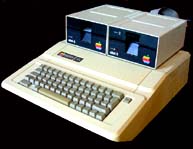ProLine
ProLine was the first communications product to truly link Apple II computers to the Internet (known as ARPANET back in the mid 1980s). Users connected via modem to exchange email and Usenet news. ProLine was essentially a version of Unix for the Apple II in less than 48K of memory. By the time I was 30, ProLine had consumed a third of my life.
The leading Apple II and Macintosh magazine, inCider/A+, awarded ProLine five full stars in the December 1992 issue, stating, “ProLine is as powerful as many UNIX minicomputer-based systems, yet amazingly, it runs on a standard Apple II. ProLine is top-notch. You can run ProLine as an independent on-line system, but it gains a new world of capabilities if you network it with other systems.”
Hundreds of ProLine systems were scattered around the globe with sites running in every major country. This contribution to computer users of all denominations brought me more pleasure than notoriety or riches.
The highly-respected Boardwatch Magazine (June 1991) admitted, “ProLine is a network of Apple II systems that are not only tied to each other, but routinely carry Internet News Groups . . . something we just didn’t expect. The speed and power of this BBS running on an Apple II were quite impressive.”
ProLine shipped on two 3.5″ 800K disks and originally sold for $259.95 — a lot of money even today for an application. It consisted of scores of BASIC programs that presented a surprisingly accurate Unix-like environment, complete with a scriptable C-shell and online “man” pages. To produce a nice printed manual, I had to learn the PostScript language — an investment that paid off again a dozen years later when it came time to make a PDF file out of the online manual.

The Apple IIe with 128K -- my first real computer. I had to make ProLine work on an old Apple II+ to run my 24-hour BBS. I later upgraded both machines to the whizzy Apple IIGS.
My own ProLine system, named pro-sol, operated continuously for over 12 years. In the mid 90s, it interfaced via serial cable to a PC running FreeBSD Unix, connected to the Internet via ISDN. Through that box, you could actually telnet into ProLine. I took it down in 1996 when we moved to a new home and decided not to keep it going. Incredibly, some people are still running ProLine systems today, nearly 20 years after its inception.
Excerpt from the author’s personal note on page 4:
“I started writing a BBS for my brand new Apple IIe, because there were no bulletin board systems that supported my modem back then … ProLine introduced me to many friends and acquaintances, some long forgotten, but many who are good friends today. It allowed me to start my own software business, and helped me buy my first home.”
My fondest memory of working on ProLine was in 1984 when Joe Holt, who wrote code for Beagle Bros, Adobe, and now Apple Computer, spent the summer at my house. He stayed up all night hacking away on ProLine, then would turn over his work and notes (in email) to me the next day to continue coding in between college classes. I’d pass the token to him that evening, and on it went for several weeks.
ProLine inspired several other MDG products: ModemWorks, AmperWorks, OMM, and especially MD-BASIC. These started out as technologies used internally, only to be fashioned into commercial-grade, stand-alone products upon which ProLine depended.
![]() ProLine.1.img 800K ProDOS disk
ProLine.1.img 800K ProDOS disk
![]() ProLine.2.img 800K ProDOS disk
ProLine.2.img 800K ProDOS disk
![]() ProLine-3.0.pdf 1MB Acrobat file, 335 pages
ProLine-3.0.pdf 1MB Acrobat file, 335 pages
![]() ProLine source code directory
ProLine source code directory
Comments
Add a Comment


Erik Siers 11.24.2009
Two things.
1) Will ProLine work on a //c?
2) The source code link is broken, sadly. I’d like to get my hands on it if possible.
Morgan Davis 11.25.2009
@Erik, thanks for the alert about the bad link. It’s fixed now.
No, ProLine will not run on a //c because it lacks necessary hardware support in the serial port for detecting modem carrier signal. Apple chose to not provide all the standard RS-232C inputs on the //c, and so that makes it fine for being a terminal, but not for being a BBS.
Erik Siers 12.03.2009
(Thanks for the source.)
Well, the //c is the only model I actually own… but I suppose I could [cough cough] emulate a different model… or something.
Morgan Davis 12.03.2009
Emulation won’t work since you’re limited to hardware. A IIe with a Super Serial Card still needs a custom RS-232C cable for DCD (carrier detect). I don’t think you can emulate that. But even better, I think there are some Apple IIGS emulators out there. That would make a much better emulated ProLine system.
Erik Siers 12.04.2009
Well… No harm trying, I suppose. I’ll just have to see what emulators are available and what each can do.
Mostly, I just want to see a *nix-ish system on an Apple 2. Is that so wrong? 🙂
Morgan Davis 12.04.2009
Go for it! I actually did this a few years ago and was astounded by the speed. Running the installer was incredible. What used to take half an hour with 3.5″ discs grinding away completed in mere seconds. Enjoy!
marco 09.13.2011
This is super cool.
I’ve got it running on an apple IIE that I want to put online. Do you remember if other discs were done apart from the version 3.0 you posted here? Or in another words the SW is entirely contained here in these two IMG?
Morgan Davis 09.13.2011
@marco: The disks posted here are all you need to get a complete system up and going. We didn’t have any additional software that we distributed for ProLine. Have fun!
Paul Hutmacher 09.27.2017
Morgan, what a blast from the past. I’m now at Microsoft working on Azure AD but fondly remember my first foray into the world of connected systems when I started my own ProLine system, pro-Europa. I recently saw a conversation where someone stated “people weren’t online in the 80’s.” I replied oh yes we were 🙂
I didn’t invent the internet but i was there when it was invented. I hope you are well.
Joseph Norton 03.05.2020
Hi:
this is the coolest thing I have done in a while.
I have it running under AppleWin and can telnet into it using a combination of programs. I’m only doing it on my local network, but, I’ve wanted to play with this for years, but, sold all my Apple hardware before I could do anything, and, all I had was a //e with one 140k disk drive.
One thing I’m puzzled about is that, under the game room, there’s an entry for “adventure”, but, when run, it says can’t execute /a/games/acs and returns to plush. What happened with that?
Going to try and remove that later today.
Morgan Davis 03.06.2020
Hi, Joseph. Thrilled that you’re playing with this and it all (mostly) works still!
Apparently, ACS was not included in the base system even though plush referred to it. Sorry about that. I can’t seem to find it in the source code available here on this site. Maybe someone else has a copy?
On that note, I just realized that the ProLine source directory (referenced at the end of this article) is no longer navigable. So I put it all into a single Zip file you can download now. Just visit the link above.
Joseph Norton 03.10.2020
Hi:
Thanks for your reply.
I would like to mention that I am a blind computer user, using various screen readers and such to accomplish what I do.
One impression I’m getting from reading the manual is that I can do just about everything by logging into the BBS, as long as I have an ANSI or other type terminal to do it with. Seems like, after creating the sysop account, there’s not much you need to take the BBS down for. Seems like you can log in if you want to and take care of most routine maintenance. Am I correct?
You were mentioning the speed at which the install went, and, you’re not kidding.
Right now, I have ProLine running under the AppleWin emulator and am using a program called “tcpser” as a modem emulator.
It seems to work, but, there are a few keyboard weirdnesses, which I get around ok. Don’t think I could do file transfers, but, I set it up with a couple conferences and invited some other blind users to telnet into it, so we’ll see what happens.
If you want to try it yourself, you can telnet into:
prodalton.sytes.net
using port 2300.
I think it’s doing speed as if it’s running at 9600, but, I’m just amazed and thrilled that I could get it to work, without a speck of Apple II hardware.
After I read the manual, setup was a breeze. I didn’t really have to read much, but, I did need to know how to create the sysop account. RTFM, right?
Thought I’d mention a couple weirdnesses, but, it’s just for information.
Register account creation went well, but, ran into a slight snag with guest creation. After I said ‘Y’ to the question asking if everything was correct, I got:
Wait…adduser: error 53 at 116
It didn’t like me entering nothing for the name.
Don’t worry, I got around it. I re-created the guest user, this time with a name, and used eduser to remove the name and that fixed it.
One more error 53 I got was in vedit. The prompt said to press ^M to insert a carriage return. Usually, I could press enter to do it, but, if I pressed ^M, it would give me this:
Fatal error 53 @ 10, press RETURN. This doesn’t happen doing it locally.
In the C-Shell, I had to explicitly use ^M or set my enter key to just use that. If I didn’t, the prompt would come back as if I had done nothing, rather than incrementing.
I couldn’t run ProLine with speech in the APPLE emulation with TexTalker, even though the Echo synthesizer is emulated in the MAME project. Guess it takes over too much. This is ok. Applewin has a neat feature letting you print the screen to the clipboard, so I was able to monitor what was going on that way, and everything went pretty well.
Another thing that is amazing is the speed at which you can maintain files.
The whole system is on a 32 meg image, and, it takes seconds if I want to copy the image to a file for backup purposes. Don’t know how long it took to back up a 32-meg drive, but, it didn’t take seconds, I know that, more like hours?
Actually, it takes longer to type the commands into the command interpreter than it does for the image to copy to a backup file. And, I’m about to backup into the cloud, while I have it, something else that didn’t exist in 1994.
Sorry to bother you with this.
I just wanted you to know you created a cool set of programs, and that, some of us are still having fun with them.
Morgan Davis 03.12.2020
Joseph, your post made me giddy and made my entire day! Thanks for sharing your experience!
Joseph Norton 08.29.2020
Hi:
Just thought I’d post an update on my discoveries.
I mentioned some keyboard weirdnesses, as well as a problem with pressing Enter.
Turns out that a lot of this was on my end, so to speak. Not that I was doing anything wrong, but, when I used puTTY or another telnet client, it put a null after the return character, and the Apple didn’t like it.
I had about resigned myself to this weirdness, when, I decided to see if I could more accurately mimic what things would have been like had I been using a real modem.
So, I created a virtual machine running DOS, put my screen reader on it and also my old copy of Telix.
Since the machine has no real serial ports, I used a program called “com0com” which allows you to create a pair of virtual com ports. I added one more pair for my DOS screen-reader and switched to the “MODEM.EMULATOR” modemcap in Pro-Line. Suddenly, when I used Telix, everything worked more naturally. It worked well enough that I could upload and download using Modem.
I now acquired another machine, and I moved my DOS vm onto it, switched back to the “STD.HAYES.V.32” modemcap and set up the “tcpser” program which works with the com port pair and looks to Pro-Line like a modem.
Now, I can keep Pro-Line running on the other machine, load up my DOS vm and start Telix.
I can then type something like:
ATD192.168.1.19 and things look something like this:
CONNECT 19200
Welcome to ProLine [pro-dalton], located in the Carpet Capital of the World!
Please log in or type register for a free account.
To log in as a guest, type guest.
pro-dalton login: jenorton
Password:
Last successful login for jenorton: 29 Aug 20 01:36:27
ProLine 3.0 (C) 1984-1994 Morgan Davis
Welcome to ProLine
from
The Morgan Davis Group
You have mail
It’s not the bullet that kills you, it’s the hole.
Welcome to the ProLine Users Shell 3.0, one moment…
Main Menu
C = Conference System
E = Electronic Mail…
F = File Library
H = Help Desk…
I = Information Desk…
G = Game Room…
M = Maintenance…
P = Preferences…
U = Utilities…
B = Bye
X = Expert Command Shell
Main Menu: B
Bye? (y/n) Y
Your session on pro-dalton ends 29 Aug 20 02:09:14 EDT…
NO CARRIER
Joseph Norton 06.25.2021
For anyone who might be reading this, and would like a copy of the y2k patch for ProLine, turns out the WayBack machine at web.archive.org actually saved a copy of the patch disk, compressed as a Shrinkit archive, with a .bxy extension (binary II wrapped Shrinkit Archive). It can be found at:
http://web.archive.org/web/20030327013712/http:/www.darsys.com/proline/
If you click on the patch disk file, it should download.
That’s the first time I’ve ever gotten a file from the WayBack machine.
I was able to successfully install it, and it seems to be doing ok.
FYI: The patch disk also contains a Shrinkit archive containing a more complete collection of games for ProLine.
Hope this helps.
Joseph Norton 06.25.2021
One more thing:
I, again, would like to thank Morgan Davis for writing ProLine, Eric A. Seiden for writing the Y2K update patch, and, Kelvin Sherlock, who directed me to the WayBack machine’s archive of Mr. Seiden’s ProLine page. Mr. Sherlock has a telnetable ProLine BBS still running. Just telnet to:
proline.ksherlock.com using port 6523.